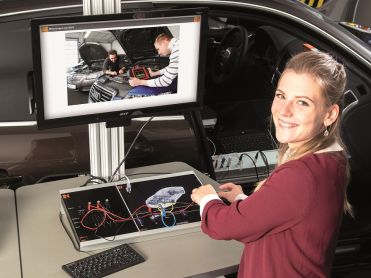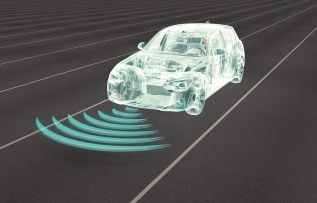Digitisation in vehicles
48 volts, CAN FD and autonomous drivingFor more than 40 years the 12 volt on-board power system was synonymous with cars. Now the 48 volt on-board power system, introduced just a few years ago, represents the next generation.The trend is clear: In the course of digitisation, the automotive industry, and by extension vocational training, must look at tried and tested vehicle components in a new light. Besides the on-board power system, there are many other examples as well, such as the CAN FD bus system, new driver assistance systems or the programming of control units via Ethernet. Our development department examined these industrial innovations very closely and developed suitable solutions for vocational training. The training solutions are based on our UniTrain experiment system. They realistically and safely show diagnostics and maintenance of the new technologies – the ideal preparation for digitalization and interconnection.
 UniTrain CAN-FD: the improved CAN bus in the classroom
UniTrain CAN-FD: the improved CAN bus in the classroom To this day, the CAN bus is doing a good job in terms of digital interconnection in our vehicles. However, in many respects the serial bus system has reached its limits. The logical development is the CAN-FD. The new bus protocol meets the requirements associated with higher data rates and ever more technical functions. “Flexible data rates” have been rapidly becoming more widespread since they were introduced to the market. Knowledge of the protocol and performing measurements on the system provide the basis for maintaining new automotive systems; and Lucas-Nülle facilitates this in a practically relevant way.
UniTrain 48 volt on-board power system: safe lessons with more voltage
Higher voltage is rather useful. The 48 volt on-board power system is a key technology that opens many doors, so to speak. Lower currents make hybridization without HV possible. At the same time, the system’s thinner cable harnesses make it more lightweight. Furthermore, the extra voltage opens up performance options with the e-booster. Working with the 48 volt on-board power system will provide an important grounding for modern vehicle diagnostics and maintenance. The safety of lessons with the higher voltages is guaranteed by the tried and tested UniTrain System.
Assistance systems paving the way for autonomous driving; multifunctional vehicle cameras.
They can recognize white lines and multicoloured road signs as well as numbers and symbols. That makes them convenient aids which assist us in tricky situations. Rear view cameras guide drivers when parking, camera recognition of road signs facilitates speed control via the navigation system. Modern vehicles are already capable of controlling the speed themselves thanks to predictive speed control systems. Driver assistance technology shows a clear trend towards autonomous driving. It is therefore important for budding automotive professionals to gain an understanding of driver assistance systems. Our development department is going to present additional UniTrain systems in 2019 that will enable you to integrate the topics into your teaching programme.
